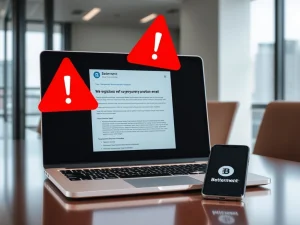Critical Warning: Dangerous Social Engineering Scams Target Crypto Wallets

In the rapidly evolving world of digital finance, the promise of innovation often walks hand-in-hand with the specter of deception. A recent and alarming trend reveals that threat actors are deploying increasingly sophisticated tactics, leveraging elaborate social engineering schemes to target unsuspecting users and drain their crypto wallets. For anyone navigating the cryptocurrency landscape, understanding these new dangers is not just advisable—it’s absolutely essential.
Unveiling the Latest Social Engineering Scheme
According to a comprehensive Darktrace report, a prominent cybersecurity company, these new schemes bear striking resemblances to the methods employed by ‘Traffer Groups,’ notorious for using malware to steal sensitive credentials and data. The core of this elaborate scam involves building trust with victims by posing as representatives from fictitious startup companies. These fake entities often operate in trending sectors like AI, gaming, Web3, and social media, lending an air of legitimacy to their operations.
- Initial Contact: The scam typically begins with an unsolicited message via popular platforms such as X (formerly Twitter), Telegram, or Discord.
- The Lure: A supposed ’employee’ of the fake company contacts the victim, inviting them to test out new software in exchange for a cryptocurrency payment. This offer of payment acts as a powerful incentive, masking the malicious intent.
- Compromised Credibility: To enhance their deception, these threat actors often utilize compromised X accounts and bolster their fraudulent claims with seemingly legitimate Medium articles and GitHub entries, creating a deceptive ecosystem of trust.
How Threat Actors Drain Crypto Wallets
The mechanics of the scam are designed to appear innocuous at first, progressively escalating to the point of outright theft. Once a user is enticed to download the ‘software’ for testing, the real danger begins. The downloaded application is, in fact, malicious software designed to exploit the user’s system.
A critical step in this process involves a deceptive Cloudflare verification bubble that appears. This seemingly routine security check is a front for the malware to begin extracting vital information about the victim’s computer. The ultimate objective, as the Darktrace report highlights, is the surreptitious theft of credentials from various crypto wallets. Both Windows and Mac users have been identified as targets, underscoring the broad reach of these sophisticated attacks.
The insidious nature of this scheme lies in its ability to bypass traditional security awareness by manipulating human trust and curiosity. By the time victims realize their credentials have been compromised, their digital assets may already be irrevocably lost.
Broader Cybersecurity Threats in the Crypto Space
The social engineering tactics detailed in the Darktrace report are not isolated incidents but rather part of a wider tapestry of cybersecurity threats plaguing the crypto industry. The year 2024 (and projections for 2025) has seen a proliferation of crypto scams, ranging from the infamous ‘pig butchering’ schemes to ‘four-dollar wrench attacks,’ and even sophisticated campaigns allegedly orchestrated by groups with state affiliations, such as those associated with North Korea.
The evolution of these scams demonstrates a clear trend towards increased sophistication, often incorporating elements like hacked social media accounts and insider fraud. Authorities worldwide are issuing warnings. For instance, Chinese authorities have cautioned citizens about illegal fundraising schemes that exploit the public’s limited understanding of cryptocurrencies, particularly stablecoins, often serving as fronts for money laundering and online gambling.
Other prevalent crypto scams that users must watch out for include:
- Malicious browser plugins disguised as security tools.
- Tampered hardware wallets designed to compromise funds.
- Social engineering through fake ‘revoker’ websites that trick users into signing malicious transactions.
- Fake crypto support scams that use psychological manipulation to extract information or funds.
The U.S. Department of Justice, for example, unsealed an indictment against two individuals for allegedly running a scheme that defrauded investors of over $650 million, highlighting the significant financial impact of these criminal enterprises.
Actionable Insights: Safeguarding Against Crypto Scams
Given the escalating sophistication of these cybersecurity threats, proactive measures are paramount for protecting your digital assets. While the threats are dangerous, vigilance and informed decision-making can significantly mitigate risk.
Here’s how you can protect your crypto wallets and yourself:
- Verify Everything: Always independently verify the legitimacy of any company, software, or individual reaching out to you, especially if they offer lucrative crypto payments for testing or services. Cross-reference information through official channels, not just links provided by the contact.
- Be Skeptical of Unsolicited Offers: High-yield investment opportunities or offers to test software for quick crypto payments are often red flags. If it sounds too good to be true, it likely is.
- Secure Your Accounts: Implement strong, unique passwords for all your crypto-related accounts and enable two-factor authentication (2FA) wherever possible.
- Hardware Wallets: For significant crypto holdings, consider using a hardware wallet for cold storage. This keeps your private keys offline, significantly reducing the risk of online theft.
- Software Vigilance: Be extremely cautious about downloading any software from unverified sources. Use reputable antivirus and anti-malware solutions and keep them updated.
- Educate Yourself: Stay informed about the latest scam tactics. Awareness is your first line of defense against social engineering.
- Report Suspicious Activity: If you encounter a potential scam, report it to the relevant authorities and inform the platforms where the interaction occurred (e.g., X, Telegram, Discord).
Conclusion: Your Vigilance is Your Best Defense
The landscape of cryptocurrency is dynamic, bringing both immense opportunity and significant risk. The latest Darktrace report serves as a stark reminder of the evolving and increasingly elaborate social engineering schemes designed to compromise your crypto wallets. As crypto scams become more sophisticated, your personal cybersecurity threats awareness and proactive measures become your most formidable defense. By staying informed, exercising skepticism, and adopting robust security practices, you can navigate the digital frontier more safely and protect your valuable digital assets from these relentless threats.









